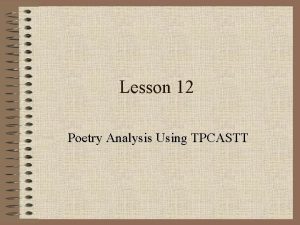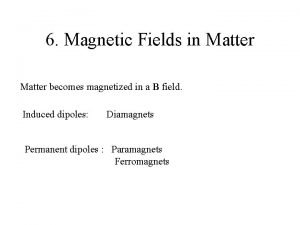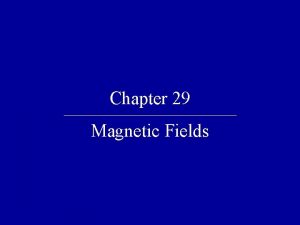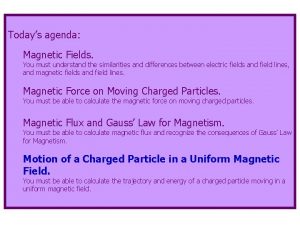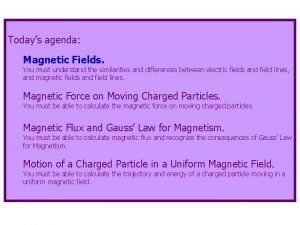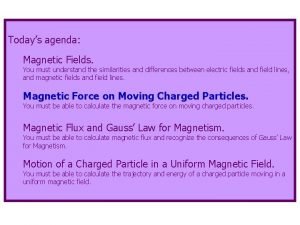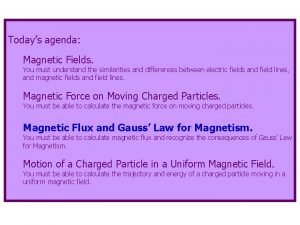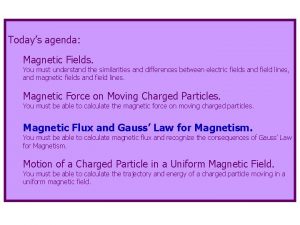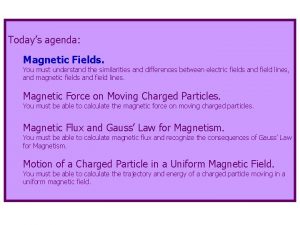Todays agenda Magnetic Fields You must understand the









- Slides: 9

Today’s agenda: Magnetic Fields. You must understand the similarities and differences between electric fields and field lines, and magnetic fields and field lines. Magnetic Force on Moving Charged Particles. You must be able to calculate the magnetic force on moving charged particles. Magnetic Flux and Gauss’ Law for Magnetism. You must be able to calculate magnetic flux and recognize the consequences of Gauss’ Law for Magnetism. Motion of a Charged Particle in a Uniform Magnetic Field. You must be able to calculate the trajectory and energy of a charged particle moving in a uniform magnetic field.

Magnetism Recall how there are two kinds of electrical charge (+ and -), and likes repel, opposites attract. Similarly, there are two kinds of magnetic poles (north and south), and like poles repel, opposites attract. S S N Repel S N N S N Repel S Attract N S N N S Attract

There is an important difference between magnetism and electricity: it is possible to have isolated + or – electric charges, but isolated N and S poles have “never” been observed. * - + N S I. E. , every magnet has BOTH a N and a S pole, no matter how many times you “chop it up. ” SS N SN N *But see here, and here.

Magnetic Fields The earth has associated with it a magnetic field, with poles near the geographic poles. The pole of a magnet attracted to the earth’s north geographic pole is the magnet’s north pole. The pole of a magnet attracted to the earth’s south geographic pole is the magnet’s south pole. N S http: //hyperphysics. phyastr. gsu. edu/hbase/magnetic/ magearth. html Just as we used the electric field to help us “explain” and visualize electric forces in space, we use the magnetic field to help us “explain” and visualize magnetic forces in space.

Magnetic field lines point in the same direction that the north pole of a compass would point. Later I’ll give a better definition for magnetic field direction. Magnetic field lines are tangent to the magnetic field. The more magnetic field lines in a region in space, the stronger the magnetic field. Outside the magnet, magnetic field lines point away from N poles (*why? ). Huh? *The N pole of a compass would “want to get to” the S pole of the magnet.

For those of you who aren’t going to pay attention until you have been told the secret behind the naming of the earth’s magnetic poles… The north pole of a compass needle is defined as the end that points towards the geographic “Santa Claus” north pole, which experts in the field of geomagnetism call “the geomagnetic north” or “the Earth’s North Magnetic Pole. ” If you think about it, the people to whom compasses meant the most— sailors—defined magnetic north as the direction the north poles of their compass needles pointed. Their lives depended on knowing where they were, so I guess it is appropriate that we acknowledge their precedence. Thus, by convention, the thing we call Earth’s North Magnetic Pole is actually the south magnetic pole of Earth’s magnetic field. For those of you who are normal humans, just ignore the above.

Here’s a “picture” of the magnetic field of a bar magnet, using iron filings to map out the field. The magnetic field ought to “remind” you of the earth’s field.

We use the symbol B for magnetic field. Remember: magnetic field lines point away from north poles, and towards south poles. S N The SI unit* for magnetic field is the Tesla. These units come from the magnetic force equation, which appears three slides from now. In a bit, we’ll see how the units are related to other quantities we know about, and later in the course we’ll see an “official” definition of the units for the magnetic field. *Old unit, still sometimes used: 1 Gauss = 10 -4 Tesla.

The earth’s magnetic field has a magnitude of roughly 0. 5 G, or 0. 00005 T. A powerful permanent magnet, like the kind you might find in headphones, might produce a magnetic field of 1000 G, or 0. 1 T. http: //liftoff. msfc. nasa. gov/academy/space/mag_field. html The electromagnet in the basement of Physics that my students (used to) use in experiments can produce a field of 26000 G = 26 k. G = 2. 6 T. Superconducting magnets can produce a field of over 10 T. Never get near an operating superconducting magnet while wearing a watch or belt buckle with iron in it!


